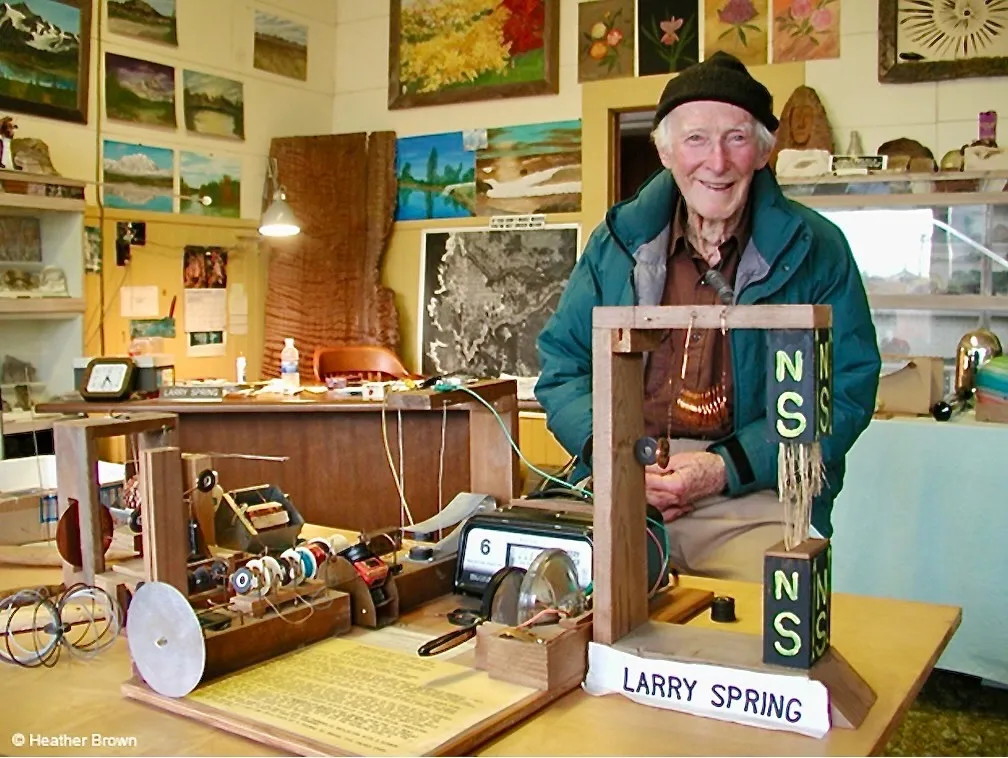Copyright Santa Rosa Press Democrat

Unless you’ve been there, it’s almost impossible to describe the Larry Spring Museum of Common Sense. Certainly, one of your first impressions is that one is walking back in time. Exhibits are displayed using Spring’s original sheets of typed paper- evoking the feeling of museums and art collections dating back to the 1950s. The collection is an astonishing array of scientific experiments, wooden animals, geological samples, paintings, writings, ramblings, and personal objects that represent the life’s work of one of the county’s more unusual heroes: Larry Spring. Spring, who was born in 1915 and died in 2009, was a man who was not confined to the ordinary. As a young person, he was exposed to scientific ideas, and when he discovered the burgeoning world of radio and television transmission, he found his passion and his vocation. This led to the opening of Fort Bragg’s first television and antenna shop, which afforded Spring the tools for a lifetime of exploration and creativity —what he encapsulated as “common sense physics.” The museum, cared for and curated by executive director Anne Maureen McKeating and a devoted group of board members and volunteers, is in need of support, and McKeating hopes the community will come together to provide the resources necessary to preserve Spring’s legacy. Following the death of Heather Brown, McKeating was given the torch of responsibility for the care and curation of the museum. “My friend Heather worked with Larry for about 10 years. She helped Larry with a variety of things- creating a website for him and doing some publishing. I started visiting Fort Bragg to help Heather, and following Larry’s death, we began ‘activating’ the museum. When Heather passed unexpectedly, I was the person who inherited the museum.” McKeating notes that living in Canada — especially these days, when crossing the border can be fraught for citizens of either country — has made managing the museum more challenging. She has assembled a small, dedicated cadre of board members who are determined to keep the museum afloat. Mixed media artist, Nathan Maxwell Cann, Anne Beck- interdisciplinary artist and team member of The Rhinoceros Project, and fourth generation Fort Bragg native and social organizer, Megan Caron, handle much of the day-to-day operation of the museum, along with local volunteers. “It’s important to celebrate our legends, and that is what the museum does,” McKeating continues. The museum was developed over the years, infused with Spring’s creative drive — starting out as the community’s humble television shop and morphing into a space that is representative of Spring’s boundless curiosity and devotion to experimentation. Spring tinkered with a variety of experiments and ideas, and his methodology can be seen in the exhibits. Like many people in his generation, Spring didn’t waste a thing. He used everything and anything to help him model his ideas. “The isolation in the Fort Bragg community at the time Larry was active was helpful to him,” McKeating continues. “This is not a university town, so Larry literally let the energy and the landscape be his teacher. That’s what we try to keep doing with our museum programming — we’re trying to channel that spirit of inquiry.” Anyone who had a TV connected to Larry at some point. He was also involved in real estate, so some folks knew Larry through the buying and selling of property. “He didn’t live extravagantly, but he had means, so when he wanted to pursue experimentation and convert the television shop to the Museum of Common Sense, he could do it. Like a lot of self-educated folks interested in art and science, Larry found the time to work on his passions following retirement.” The walls of the museum are filled with Spring’s paintings, and to be brutally honest, they probably don’t represent the pinnacle of his creative genius. “We have heard anecdotally that Larry loved Bob Ross. From what we can tell, Larry painted mostly from photographs. In his archives, we have found photos that correspond pretty closely to some of his paintings.” Spring painted as a way of memorializing places that he had visited. His feather paintings are probably the most conventionally well-done pieces in terms of artistry. What Spring was, says McKeating, was an excellent photographer. “Larry left us an extensive photo collection. His compositions are complex, especially the photos taken during his military service in North Africa. You can see that a lot of soldiers would go to these places and stay apart from the population because of their limited comfort level. Larry got right in there. We have a huge slide collection and beautiful images of his travels.” In the museum’s back room, Spring’s mineral collection is displayed, and the cases are filled with his quirky and often amusing comments about the minerals and specimens he found. “Larry was a rockhound. He traveled around, largely in the American Southwest and California.” He was a member of the Mendocino Coast Gem and Mineral Society, and was particularly fond of picture stones, and named what he saw with whimsy and a practiced eye. One wall of the museum’s front room holds a display case filled with his “Little Wooden Creatures,” animals made from found pieces of wood that he enhanced to make even more realistic. “We’ve seen photos of them in someone’s home from the 1950s. Larry had them on display in the television store. He had a brochure made that would invite people to come into the store to see the wood creatures free of charge. He was definitely a bit of a showman,” McKeating smiles. They were never offered for sale. And then there are Spring’s experiments. He used some of his television equipment to measure and verify the speed of light. He spent years verifying a wide variety of scientific theorems, including verifying the speed of electrical current in the television lead line, verifying Lenz’s Law — a new basis for understanding friction, verifying the Quantum Theory, and verifying that an electrical current produces a circular magnetic field around a wire. He made even more “discoveries:” discovering the spherical shape of a quantum, which he labeled a Magnesphere. He conducted many experiments around the concept of the Magnesphere, which involved them producing alternating polarity, stating that they were affected by compression and expansion, and that they produced alternating polarity by alternating current. From there, he discovered what he called the non-orbiting “Spring Atom,” in which an electron is a neutron and proton pair. Magnetism fascinated Spring, and many of his experiments revolved around the use of magnets. He was an early proponent of solar energy and developed what he called “The Mendocino Brushless Levitating Solar Motor,” which demonstrated his interest in magnets and solar energy. There’s been very little updating to the displays of the museum, which is by design, according to McKeating. “When younger people come in, they cannot believe what they’re looking at. They’re so used to second-hand experiences mediated by a screen. We kept it analog very deliberately, to preserve the feeling of nostalgia. I’ve always loved small collections. When you walk into these historic places, there’s even an aroma that you can sense. The museum works on all of the senses, and we keep it active by having new and different exhibitions.” “Larry was known to freely welcome everyone to his place. He wasn’t just a traditional old-timer. He was expansive and generous,” says McKeating. That generosity has continued, with the museum being a gathering place for music, arts events, poetry, and workshops. “Larry used to have classes in here. We’re trying to do the same thing, to support the culture of the commons by being collaborative and sharing resources.” Given the dwindling state of resources for projects like the museum, McKeating feels this generosity needs to be fostered between all like-minded organizations. Currently, the museum is sharing space with Redwood Time, an ongoing community arts and science installation co-curated by Ann Beck. The project focuses on a creative rethinking, re-imagining, and re-visualization of the timeline suggested by the tree rings within Fort Bragg’s C.R. Johnson’s Memorial Redwood Tree. “We will be continuing to work on stitching the Redwood Time fabric maquette over the winter.” The maquette is a 1:1 scale depiction of the iconic redwood round, but with new conceptions of time and place adorned on it. A loss of grant funding has forced the museum to pare down some of the original activities planned for this project. “We’ve been seeking funding to exhibit at the dry sheds at the Mill site. Our hope is to have the community version return to the dry shed and display it up there.” The museum is reaching an inflection point. “We’ve always maintained that the museum was in a state of what I call ‘curated decay.’ It’s sort of a tip of the hat to the ever-changing nature of all things. I believe it would be Larry’s wish that some things were allowed to decay.” Some restoration projects are beyond the expertise of McKeating, the board, and volunteers. “I know enough to know that I’m not doing the right thing,” she smiles. The physical state of the building—and its impact upon the health of the collection has McKeating concerned. “We painted the outside with a sealant to protect the building from dampness. We run dehumidifiers and read the relative humidity on a regular basis—not that there’s much we can do about the humidity.” Some of Spring’s real estate papers have been archived by the Fort Bragg/Mendocino Coast Historical Society. Because of all these different types of items in the museum’s collection, real conservation is impossible.” “Keeping the museum afloat is not easy. We are in a crunch, trying to figure out how to keep it sustainable.” The loss of grant funding has hit the museum hard. “We’re at a point where we need donations and partnerships, or we’ll have to begin creating a succession plan for the collection. We’re putting together a membership and sponsorship program that will be launched soon. But we need sustainable cash flow to keep going.” Norm De Vall knew Spring and had a perfect description of him. “Norm told me, ‘We were all coming up here from the Bay Area during the Cold War. All kinds of wacky stuff were going on. There was a television store where Larry worked. We just called it Larry’s Place, because no one was totally sure of its primary purpose.” “That’s what we’re trying to continue,” McKeating explains. “Larry’s ashes are in the museum. That big lamp on his desk? That’s Larry,” she smiles.



